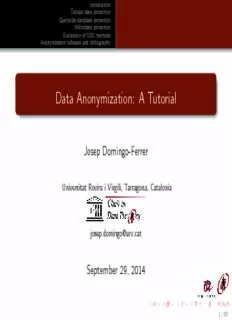Table Of ContentIntroduction
Tabulardataprotection
Queryabledatabaseprotection
Microdataprotection
EvaluationofSDCmethods
Anonymizationsoftwareandbibliography
Data Anonymization: A Tutorial
Josep Domingo-Ferrer
UniversitatRoviraiVirgili,Tarragona,Catalonia
[email protected]
September 29, 2014
1/68
Introduction
Tabulardataprotection
Queryabledatabaseprotection
Microdataprotection
EvaluationofSDCmethods
Anonymizationsoftwareandbibliography
1 Introduction
2 Tabular data protection
3 Queryable database protection
4 Microdata protection
Perturbative masking methods
Non-perturbative masking methods
Synthetic microdata generation
5 Evaluation of SDC methods
Utility and disclosure risk for tabular data
Utility and disclosure risk for queryable databases
Utility and disclosure risk in microdata SDC
Trading off utility loss and disclosure risk
6 Anonymization software and bibliography
2/68
Introduction
Tabulardataprotection
Queryabledatabaseprotection
Microdataprotection
EvaluationofSDCmethods
Anonymizationsoftwareandbibliography
Introduction
Statistical databases contain statistical information
They are normally released by:
National statistical institutes (NSIs);
Healthcare organizations (epidemiology);
or private organizations (e.g. consumer surveys).
3/68
Introduction
Tabulardataprotection
Queryabledatabaseprotection
Microdataprotection
EvaluationofSDCmethods
Anonymizationsoftwareandbibliography
Data formats
Tabular data. Tables with counts or magnitudes (traditional
outputs of NSIs).
Queryable databases. On-line databases which accept
statistical queries (sums, averages, max, min, etc.).
Microdata. Files where each record contains information on
an individual (a physical person or an organization).
4/68
Introduction
Tabulardataprotection
Queryabledatabaseprotection
Microdataprotection
EvaluationofSDCmethods
Anonymizationsoftwareandbibliography
Utility vs privacy in statistical databases
Statistical databases must provide useful statistical
information.
They must also preserve the privacy of respondents, if data
are sensitive.
=⇒ statistical disclosure control (SDC) methods are used to
protect privacy
=⇒ SDC methods modify data
=⇒ SDC challenge: protect privacy with minimum loss of
accuracy.
5/68
Introduction
Tabulardataprotection
Queryabledatabaseprotection
Microdataprotection
EvaluationofSDCmethods
Anonymizationsoftwareandbibliography
Disclosure concepts
Attribute disclosure. It occurs when the value of a confidential
attribute of an individual can be determined more accurately
with access to the released statistics than without.
Identity disclosure. It occurs when a record in the anonymised
data set can be linked with a respondent’s identity.
Note that attribute disclosure does not imply identity disclosure in
general, and conversely.
6/68
Introduction
Tabulardataprotection
Queryabledatabaseprotection
Microdataprotection
EvaluationofSDCmethods
Anonymizationsoftwareandbibliography
SDC vs other database privacy technologies
SDC seeks respondent privacy.
PPDM (privacy-preserving data mining) seeks the data
owner’s privacy when several owners wish to co-operate in
joint analyses across their databases without giving away their
data to each other.
PIR (private information retrieval) seeks user privacy, i.e. to
allow the user of a database to retrieve some information item
without the database knowing which item was recovered.
7/68
Introduction
Tabulardataprotection
Queryabledatabaseprotection
Microdataprotection
EvaluationofSDCmethods
Anonymizationsoftwareandbibliography
Brief history of SDC
Seminal contributions: Dalenius (1974) from NSIs, Schl¨orer
(1975) from the medical community, Denning et al. (1979)
from the database community.
Moderate activity in the 1980s, summarized in Adam and
Wortmann (1989).
Renewed interest in the 1990s by NSIs: Eurostat and U.S.
Census Bureau promote dedicated conferences and the EU 4th
FP funds the SDC project (1996-98).
Widespread interest since the 2000s: with the advent of
WWW, the data mining community enters the field, without
much interaction with the NSI’s continuing activity.
8/68
Introduction
Tabulardataprotection
Queryabledatabaseprotection
Microdataprotection
EvaluationofSDCmethods
Anonymizationsoftwareandbibliography
Outline of this talk
Tabular data protection.
Queryable database protection.
Microdata protection.
Conclusions.
9/68
Introduction
Tabulardataprotection
Queryabledatabaseprotection
Microdataprotection
EvaluationofSDCmethods
Anonymizationsoftwareandbibliography
Tabular data protection
Goal: Publish static aggregate information, i.e. tables, in such
a way that no confidential information can be inferred on
specific individuals to whom the table refers.
From microdata, tabular data can be generated by crossing
one or more categorical attributes.
Formally, given categorical attributes X ,··· ,X , a table T is
1 l
a function
T : D(X )×D(X )×···×D(X ) =⇒ R or N
1 2 l
where D(X ) is the domain where attribute X takes its values.
i i
Number of cells usually much less than number of
respondents.
10/68
Description:Non-perturbative masking methods Let the propensity score pi of record i of Then utility is high if the propensity scores of the anonymized and.

